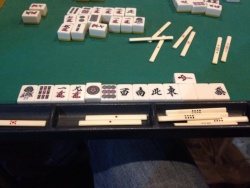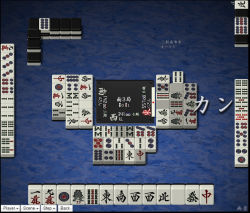Kokushi musou
| Type | Yakuman |
|---|---|
| Kanji |
国士無双 国士無双13面待ち |
| English | Thirteen orphans |
| Value | Yakuman (closed only) |
| Speed | Slow |
| Difficulty | Hard |
Kokushi musou 「国士無双」, also simply known as kokushi, is one of the standard yakuman hands. This hand is one of the two exceptions of the "four melds and one pair" rule of forming a hand, where the other exception is the chii toitsu. It consists of one of each terminal tile from each suit and one of each honor tiles. The 14th tile must be a duplicate of any terminal or honor tile. These tiles are classed as yaochuuhai 「幺九牌」. If a player draws the thirteen different tile types before pairing any of them, then the hand is of the 13 wait variety, junsei kokushi musou 「国士無双13面待ち」. As the hand requires specific individual tiles, this hand remains closed to qualify.
Tile diagram
The hand requires nothing but yaochuuhai.
Kokushi musou single wait
Kokushi musou 13-way wait
![]()
![]()
![]()
![]()
![]()
![]()
![]()
![]()
![]()
![]()
![]()
![]()
![]() Winning tile: Any one of the tiles shown here
Winning tile: Any one of the tiles shown here
- Winning from this wait may be worth two yakuman in some rules.
Meaning and usage
The word kokushi can be translated as "distinguished citizen"; the word musou is often translated as "peerless". The word kokushi should not split up and expressed as "Koku shimusou". This is an incorrect spelling.
Development
Restricted as closed only, this hand must draw at least 12 of the 13 tile types, among the honors and terminals. If a pair exists within the hand upon tenpai, then naturally, the hand is waiting on the last remaining tile type not yet in the hand. In turn, this hand will be deemed impossible for completion, when all 4 of any of the tile types are no longer available. Yet, if a player manages to develop the 13 wait variety, then this hand greatly increases its chances of completion, needing to simply pair any of the 13 types.
Reasonable development of this hand begins with a dealt set of tiles that gives a player the option to call kyuushuu kyuuhai. Declining this option puts the hand on the path to form this yakuman.
Attempting kokushi

| Kyoku | Yaochuhai start | Discard at tenpai | Result | Lobby | Link |
|---|---|---|---|---|---|
| 東局2本場1 | 9 | 9th | Ron after 12th | 上級 | [1] |
| 東局2本場1 | 9 | 6th | Ron after 6th | 7447 | [2] |
| 南局3本場0 | 10 | 4th | Ron after 5th | 鳳凰 | [3] |
| 東局1本場2 | 8 | 15th | Haitei ron | 特上 | [4] |
| 南局4本場0 | 7 | 11th | Ron after 12th | 上級 | [5] |
| 南局2本場0 | 11 | 2nd | Ron after 2nd | 7447 | [6] |
| Yaochuhai start includes the initial draw. | |||||
Any player attempting kokushi musou makes the decision at the beginning of the hand. This decision stems on a couple conditions, by which the primary decision rests on the number of unique yaochuhai at the start. The points and the current hand also influences the decision.
Kyuushuu kyuuhai
Realistic chances to complete kokushi musou may require a hand to begin with at least 9 yaochuhai. Even so, at this point, this gives a player the option to defer and abort the hand, rather than trying for kokushi.
Value
This hand is a yakuman hand. Some rules may apply double yakuman for the 13-wait variety.
Chankan rule variation

A kokushi tenpai hand may be awarded a win via chankan, if another player calls an ankan (closed kan) with that particular winning tile. Thus, ron may be declared in that instance. This is the only case where a tile may be taken from an closed kan. However, this particular rule may be subject to variation, which may or may not allow the play to occur.
External links
- Kokushi musou in Japanese Wikipedia
- Osamuko.com entry on Kokushi
| |||||||||||||||||||||||||||||||
| ||||||||||||||||||||||

